Dateline – June 12, 2005
Way back in the summer of 1979 my dad took an astronomy course at the University of North Texas (North Texas State University in those days) in Denton, TX. The course was held at the University’s Observatory, which my dad told me was located in an old missile base just a couple of miles north of Denton.
I was just a boy in the late 70’s, but I was still very aware of and concerned about the Cold War between the United States and the Soviet Union. Discussions about the balance of military power, and the merits of different weapon systems were common topics on the network news shows back then, and as a budding history and military buff, I was very interested in it all. Naturally, discovering a missile base so close to home intrigued me a great deal.
I pressed my dad for more details about the base… What kind of missiles did it operate? When was it shut down? Was it an Army base or an Air Force base? Unfortunately, he wasn’t able to provide much more information. The only clue he left me with was his belief that there were missile silos somewhere on the observatory’s property. This was just enough information to keep my curiosity about the base on a low simmer for the next several years.
When I got older and began to drive, my travels would occasionally take me out by the old missile base. On my first trip to the area I found the facility being used as the University’s observatory very easily. It was located near the intersection of FM 2164 and FM 3163 (Locust St. and Milam Rd.), and was unmistakable. I was surprised to discover, however, that there was another abandoned military facility about a mile south of the observatory on FM 2164. Now, I knew of two military bases north of Denton, without any real clues as to what type of installations they were.
Fast forward to the late 1990’s. It had been years since I last thought about the old military bases in Denton, but on this day in 1998 it occurred to me that I might be able to learn something more about them on the internet. I did a Google search on Denton TX missile base, and some tantalizing clues came back. With this search, I found enough information to convince me that at least one of the locations in Denton was a Nike anti-aircraft missile battery, and that the other location might possibly be an Atlas intercontinental Ballistic Missile base out of Dyess Air Force Base in Abilene. Still, nothing I found was definitive, and I knew I’d have to keep searching if I ever wanted to know the true story about the Denton bases.
In April of this year, I once again found myself driving by the old Denton bases, and this time I had my camera with me. I stopped and took a couple of pictures of each location. I noticed right away that a few things had changed since the last time I was up this way. The city of Denton has become a good deal larger in the intervening years, and the outskirts are quickly growing towards the old missile bases. It also appears that the southern location is no longer abandoned. It seems to be a private residence now, complete with a brand new satellite dish. After taking my pictures, I rushed home, inspired to finally get the full story about these to old military facilities.
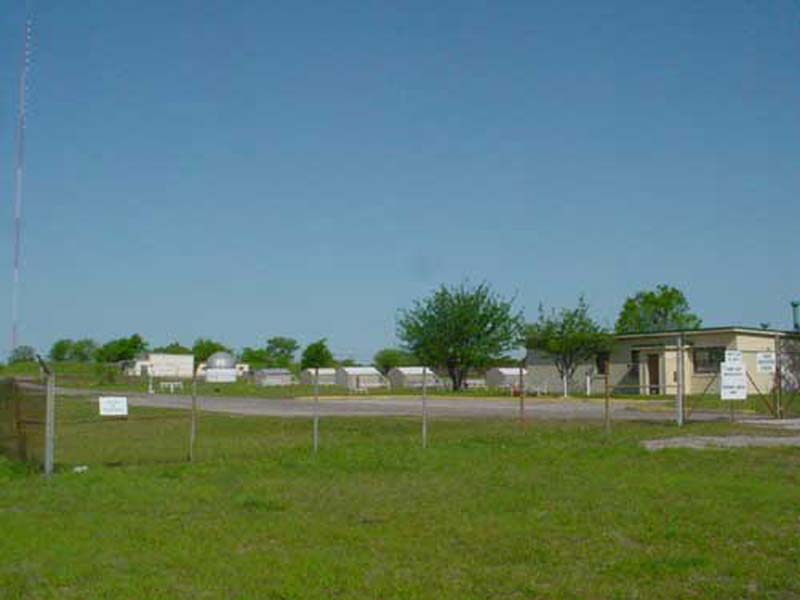
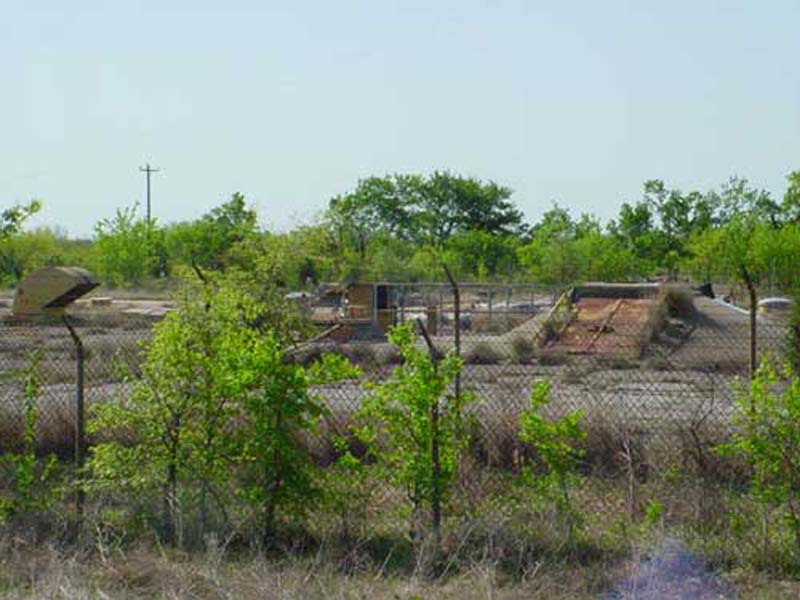

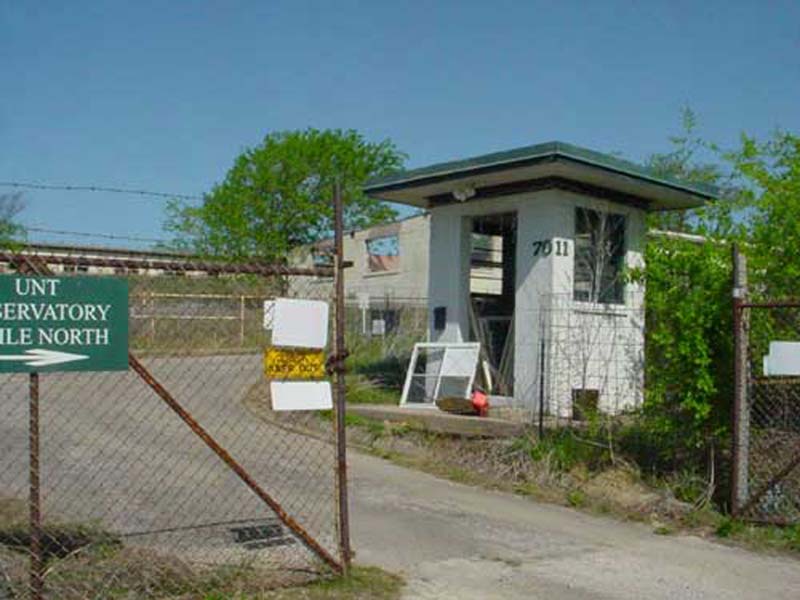
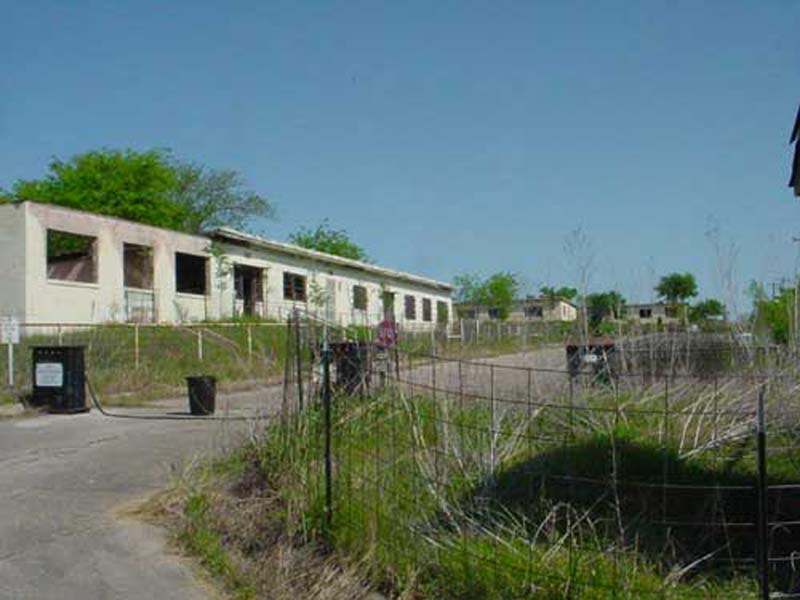
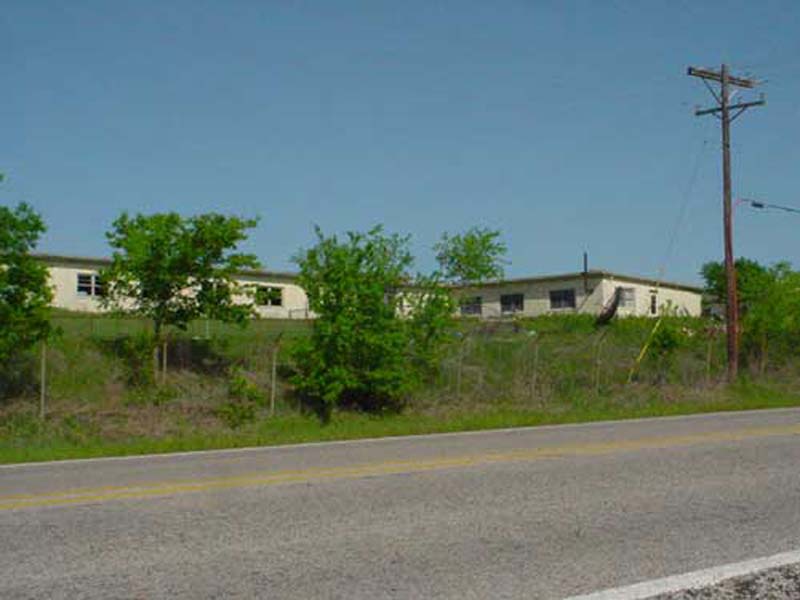
Back at the house, I began a new internet search, and this time I found a good deal more pertinent information. The first thing I was able to verify is that neither of the two locations were ever an Atlas Missile Base. My earlier confusion about this came from the fact that there is a small town just southeast of Abilene named Denton Community. Apparently Denton Community near Abilene had an Atlas missile silo, but Denton near Dallas/Fort Worth did not.
The second thing I discovered was a number of web sites dedicated to the Nike Missile System. On one of these sites I was able to verify that both of the locations in Denton were part of the same Nike Missile installation (DF-01). The south location was the Integrated Fire Control (IFC) area, and the north location was the Launcher area. Finally, things were starting to come into focus.
I found the final piece of the puzzle in the guest book of one of the Nike web sites. The guest book contained the email addresses of several of the service men who worked at the Denton facilities. I fired off a couple of quick emails, and soon got responses back from a couple of great guys. Bob Dewlen and Don Franklin were very agreeable about answering my questions about the base. In addition to answering my questions, these guys also provided me some great newspaper clippings, and links to more Nike Missile System web sites, all of which can be found below:
What was the official mission of the base?
Bob: It was to protect the DFW area from possible enemy (Russian) nuclear attack via long-range bombers. This was a real concern during the cold-war era of the early-mid 1950’s. About this time, the Soviets had acquired nuclear weapons and had begun open aggression against the west by supporting the North Koreans and Chinese in the Korean War and continually creating tensions in West Berlin and in all over Europe in general. Many thought that they planned to continue or accelerate their plan of world domination by communism, including future attacks against the continental US. The Nike Hercules antiaircraft missile systems were quickly developed and deployed to protect against this threat. Most major population centers in the US were ringed by Nike sites, especially the ones in the more vulnerable coastal areas. The DFW area had Carswell AFB (a major B-52 Base), Camp Wolters (Mineral Wells), Dallas Naval Air Station, Ft. Hood, Bell Aircraft, Chance-Vaught Aircraft and at least one other aircraft mfg. plant, TI, and probably many other defense-related industries that were thought to be attractive targets for enemy attack, hence the development of the sites there.
Don: Carswell AFB was home to the super secret B-58 Hustler at that time too. It was a new, single mission, supersonic aircraft designed specifically to deliver nuclear warheads to the enemy (aka: Russia) The B-58 was being built there at the adjacent Convair plant (now days known as Lockheed). I personally think that the Convair plant, Carswell AFB and the military industrial complex (LTV, Chance-Vaught, Bell Helicopter etc) around here were of greater interest to the DOD than the DFW area in general.
Do you know when the base opened, and what was its name?
Bob: It opened in early December, 1959, when we all moved over from Camp Wolters in Mineral Wells, where were we were temporarily housed until the Denton facility was completed. Prior to that, it was under construction for 1-2 years. The official name was: A Battery, 4th Missile Battalion, 562nd Artillery.
How was the opening of the base received by the public in the Denton area?
Bob: We were very well-received for the most part. Denton had not had any type of military presence (except maybe a Reserve/N.G. unit) since WWII. We generated a lot of public interest and tried our best to present a good public image through open-houses, etc.
I know there were several other Nike bases around Dallas/Fort Worth (Terrell, Duncanville, Alvarado, Mineral Wells). How did the people of Dallas/Fort Worth feel about the missile bases?
Bob: About the same as Denton, I suppose. People of this era were pretty matter-of-fact about the need to build a strong defense against the Soviets.
I have found some indications that before the Nike Base was constructed the site was an airfield (Hartlee) used for training during WWII. Is this correct?
Bob: No, it was never an airfield. The site is located on rather hilly terrain and was ranch land prior to the base being located there. The land had to be expropriated by the US from the lady who owned it and she was always rather hostile toward us after that. (She still owned all of the surrounding land).
The Hartlee Field to which you refer was located a few miles NE of Denton, just beyond the new loop and on the so. side of Hwy 428, and was a training field for glider pilots in WWII, as I understand it. When I was stationed at the missile base, Hartlee was a little general aviation airport with several hangars and a nice grass runway. I took my first ride in a small airplane there at a little flight school in 1960. According to my current FAA sectional maps, it is now a privately owned airfield and is closed to the general public.
Bob (with a follow up answer): Regarding the location of an airfield on the Nike site, I got to looking into that and found a website Abandoned and Little-Known Airfields which looks at a number of abandoned airports in the north Texas area. It is dedicated mainly to the old Amon Carter/Greater Southwest Int’l Airport (which we used to fly to Ft. Bliss to fire in 1960), but it also covers the old Hartlee Field. The site also shows a 1944 pilot’s sectional map showing the existence of an airfield west of the missile base shown only as Denton Field, so your information may be correct. To further confuse things, it has a 1945 sectional map which refers to that same location as College Field. It further shows an aerial photo of the area of “Denton Field” which has the IFC area shown on it. It is pretty hilly in there, but on the aerial photo, it looks like there is a place west of the base where a grass runway could have been. So, I guess that there could have been an air field there all the time we were, but time just sort of swallowed it up and we never noticed it. Come to think of it we didn’t venture onto the land surrounding the base much if ever, because the landowner it was so hostile towards the Army. And from the looks of the aerial photo, the only areas level and long enough for a runway would have required a quarter mile or more walk into “enemy territory” from the IFC area.
How much of the area surrounding the missile base was government property?
Don: The IFC area was only 10 acres and the Launcher area was about 30 to 40.
Up until the time they put in the loop 288 extension in the early 1990’s the missile base was a fairly remote location. How isolated was it when you were stationed there?
Bob: Everything north of where the new library is on N. Locust St. (hwy 2164) was pretty much open pasture land. There wasn’t very much traffic on the road at all.
What was the Denton area like when you were at the base?
Bob: It was about like it is now, except for a smaller population and the absence of all of the surrounding bedroom communities. Once you got south of the present I-35, there were many miles of open farmland between Denton and Ft. Worth and Dallas.
It had the two colleges and a farm and ranch economy in addition to being the county seat. Denton proper is remarkably unchanged from 1959-60: the major changes are the interstate and the dramatic growth around Denton.
Don: Lake Dallas was quite small at that time, of course there was no I-35 E or W, and the only road to Ft Worth that I was aware of was 377. (I used to have to drive a large Army truck (2 1/2 ton transport) to Carswell Air Force base bi-weekly and 377 was my only way there. University Blvd was Hwy 24, instead of 380 as it is called now days. The Missile Base was on North Locust, rather than Hwy 2164 as it is called today. Our Missile Base and the VFW were the only places in Denton County that were legally allowed to have and sell beer to its “members”. Other sources were some (very limited) parts of Dallas, same for Ft Worth but a lot more available than in Dallas, and across the Red River in certain areas.
How many people worked at the base?
Bob: +/- 120 people.
Where did the people who worked there live?
Bob: Most soldiers were single and lived in one of two barracks in the IFC area. Married men received a housing allowance and lived in Denton.
Was the missile system the Nike Ajax or the Nike Hercules?
Bob: Initially, it had both kinds: One section of Ajax and two Sections of Hercules. After a year or two, the Ajax was replaced with the Hercules.
If the missile system was the Nike Hercules, were the missiles armed with nuclear warheads?
Bob: Yes
How many missiles did the site control?
Bob: 18, I think, if they were they were all Hercules missiles; a few more when we had both the Hercules and Ajax types.
Were the missiles ever placed on the launchers or did they stay underground most of the time?
Bob: They usually stayed underground unless they were being used in a drill, were being tested with test equipment or we were in a really high state of operational alert.
Were the missiles ever visible from the road?
Bob: If they were raised to the straight-up firing position, they could be seen. Otherwise, they were pretty well concealed from the road. After all, they were over a quarter mile from the road and behind a 25′ earthen berm.
Don: They were quite visible when in the raised position (they were bright white and no effort was made to hide them) but that road was a very seldom used back then aside from a local farmer or two during the daylight hours. Obviously the missiles spent most of their lives underground and only came “top side” for drills and occasional maintenance.
Its seems that the missiles were oriented so that they pointed north only. Could the Denton base engage targets coming from other directions as well?
Bob: It only seems like the missiles were “pointed” north because the missile launchers were situated to the north of the Fire Control Area. However, the missiles were fired essentially straight up and upon being fired, could attack targets in any direction.
Don: I believe the missiles could go in any direction after they were launched. All launch sites were oriented away from the area they were designated to protect. That in itself seems like a natural way to set things up but it was also to create a booster drop zone outside the area of protection too.
Were missiles ever fired from the base?
Bob: None were ever fired from their home sites in the continental US. We went to McGregor Guided Missile Range near El Paso every year, where we fired two missiles for score. In December, 1960, the Denton Site fired the highest score over all other Nike sites in the US, and in so doing we won the Army Air Defense Command’s “Commanders Trophy” for the year.
Do you know where the booster drop zone was located?
Bob: Approximately 1 mile north of the launcher area.
The base seems to be divided into two parts, the missile battery in the north and the tracking center in the south. Is this correct?
Bob: Yes, the IFC (Integrated Fire Control) area was to the south and the Launcher Area was a mile or so to the north of it.
Where did you work? Can you tell me a bit about your job responsibilities?
Bob: I was a school-trained “Guided Missile Installation Electrician”, responsible for the operation and repair of all the “Army Corps of Engineers” equipment on the site. This equipment consisted of the hydraulic elevators that raised the missiles from the underground magazines, air conditioning, heating and ventilation equipment in the radar vans and underground magazines, diesel electric generators, high voltage frequency converters (converted 416v/60 cycle power to 416v/400 cycles per second) and a high-pressure, 5000 psi air compressor. I had an office in the generator building in the launcher area, since that was where most of my equipment was. In early 1961, I was transferred to a Hawk Missile unit in Germany and spent the next 18 months in that unit.
Don: I was based here with Bob from 12/59 until 7/62 and I worked in the Assembly building where we assembled, tested, and maintained the missiles. The assembly personnel also did the fueling and warheading of both the Ajax (3 high explosive warheads per missile) and the Hercules which, in the case of the Denton site, were all nuclear rounds designed to destroy whole formations of incoming long range bombers as well as the weapons they carried.
How did you guys spend your down time? Where did you hang out? Were trips to Dallas common?
Bob: We did a lot of different things in our off-time. A lot of our guys were from the DFW area and from nearby Oklahoma, so were able to go home fairly often. The base also had access to beachfront property on Lake Dallas and we liked to go there. The abundant night life in Dallas and Ft. Worth was popular on paydays and there were pretty young ladies to pursue in Denton from all of the schools there. A lot of the single guys hung out on the two college campuses and some took night-college classes at UNT. Some had night jobs in Denton to supplement meager army pay.
Don: Denton was blessed with Texas Woman’s University and North Texas State University (now UNT) so there was not a lot of need to wander far afield to find interesting things to do. There was however a good deal of travel to Dallas and certainly to Fort Worth too. Many of the guys were from Oklahoma so a lot of travel up that direction took place also.
What can you tell me about the layout of the base? Can you help me identify some of the buildings?
Bob: IFC Area: The First Long (Administrative) Building on the street housed the Day Room (TV, Recreation room), the Orderly Room (housed clerks and First Sgt.), C.O. and X.O. offices, Supply Room, Armory (small arms storage), a small Barbershop, PX, and Communications Room. On the hill behind the admin bldg. was the IFC Platoon Barracks and to the right of the Admin. Bldg. was the Launcher Platoon Barracks and Bachelor Officers Quarters (BOQ). Up the hill from the barracks was the mess hall. Around the bend in the road and on top of the hill were the Generator Bldg., the Radar Tracking and Battery Control Vans and three (later four) radar antennae. There was an Acquisition Radar antenna in the center surrounded on either side by the Target Tracking Radar (TTR) and the Missile Tracking Radar (MTR). In about 1961 or so, they began to install a High Power Acquisition Radar (HIPAR) to increase the range and quality of the acquisition radar system and this included the building of a large geodesic dome style of radar antenna adjacent to the others. The foundations for all of the radar antennae are still on top of the hill today. The IFC area also had a parking lot, a basketball court, water well and storage tank and underground diesel storage tanks.
Launcher Area: The building closest to the road is the Ready Room, where the launcher crew slept during times of alert. It had living, sleeping and shower facilities. The next building to the west (ignoring the little huts and small observatory) was the Missile Assembly Building, where the missiles arrived in “cans” for assembly and electronics-testing prior to war-heading. The building next to the Assy. Bldg and next to a large earthen berm was the Generator Building, which housed four, 150 KW diesel generators. Behind the berm was the Warhead/Fueling Building, where all warheads were installed prior to the missiles going into the underground storage magazines, and where all Ajax-type missiles were filled with liquid fuel and a really hazardous (red fuming nitric acid) oxidizer. The Hercules had solid-fuel rocket motors and didn’t require this step. To the immediate west of the Warhead Bldg was the Launcher Area, a large paved area surrounded by double fences and patrolled by guards and attack dogs. In this area were 3 underground storage pits with missile elevators, missile transport rails and launchers mounted topside for moving and raising missiles into firing position. When in firing position, the missiles stood at +/- 85 degrees.
There seems to have been a transition from Army control to National Guard control of the base. Can you tell me a bit about that? When did it occur?
Bob: It was in mid-late 1964.
When was the base closed?
Don: It occurred in 1968 (may have been finished in ’69).
Why was the base closed? Can you tell me a bit about the politics of the closure?
Bob: I don’t think that politics were involved. Although the Hercules was an outstanding and accurate missile system, it had outlived its purpose here in the US once the Soviets developed ICBM delivery systems that would reach the US. The Nike Hercules was not designed to take out ICBM’s and the Army’s research on and attempt to develop a Nike Zeus anti-missile system ultimately was not successful. To this day, the US does not have a viable way to intercept and kill incoming ICBM’s. The Hercules was still being used recently by some of our allies in Europe, Turkey and Korea since those countries are still vulnerable to attack by aircraft from nearby countries.
Don: As Bob explained, simply because the threat of long range bombers had given way to the ICBM’s on both sides of the Iron Curtain and the Hercules was no longer a deterrent. Additionally, the US and Russians had conducted the SALT talks about that time and the disassembly of nuclear weapons was taking place on both sides. We got credit for every nuclear weapon we took out of service and the Herc’s counted the same as a long range nuclear weapon so they had to go. Like Bob mentioned, the Army was working on the Nike Zeus (anti missile missile) program and we all thought we would be involved with that weapon someday but it never was successful and to this day there is still no such weapon system in our inventory.
Can you tell me a bit more about the security around the site. I find it very interesting that the military felt comfortable installing nuclear weapons on the site without controlling more of the surrounding land. When I took my pictures of the site, I noticed the guard dog kennels at the launcher site. How often did the dogs patrol? Were there dogs at the IFC? How many people were involved in security, and how were they armed?
Bob: The dogs usually were used at night inside the fences surrounding the missile magazines and were not used in the IFC Area. Only guards were used there. The dogs were usually only used after regular work hours, since there would be crew members around most of the day. The army was more concerned about securing the Atomic warheads than the barracks and mess hall. Plus, there were always people in the IFC area after hours and security was not as big a concern there as in the launcher area. It must have been a pretty good strategy because I never heard of any breaches in security at any site in the US. I think that there were 4 dog handlers and some MPs, plus some of the regular missile and radar crewmen pulled guard duty at times too. The guards usually had a side arm and an M-31 carbine. The guards in the high security area around the missiles also had attack dogs and sawed off shotguns with buckshot.
Don: Actually the security on the base was very good. The nuclear material came to us in the form of a warhead, manufactured by a civilian contractor (and delivered to us via civilian 18 wheeler escorted by armed, Army MP’s) and all we did was install it on the missile, program it to arm at a particular altitude after launch (it was a lot more involved than it sounds of course) and then babysit it from that point forward. No one was ever allowed to be near the missiles alone. There was a “2 man” rule that applied to everyone inside the second fence 24/7/365 (a minimum of 2 men were required to be together everywhere and NO ONE could be alone inside that 2nd gate). There were 3 fences around the Launch area (in General terms that is). Once you were inside the first gate, in the area of the “ready room” there was not a great deal of security concerns. When you entered the second fence, with access to the assembly, fueling and warheading areas you were under the “2 man” rule from that point forward. It was particularly enforced when you entered the 3rd fence that allowed physical contact with the missiles and in my 3 years there, I never saw anyone bust that particular rule. It just wasn’t done! You have to also take into account that the 60’s were a lot nicer times than we have now. Patriotism was a very important thing. That was back in the dark ages when we thought the Russians were the liars and the US Government always told the truth. We had armed guards on each of the gates and they would NEVER have allowed anyone to enter those areas alone or, in the case of VIP’s and high ranking visiting officers, unescorted by qualified personnel. We were young and idealistic at that time and believed very strongly in the good guys vs the bad guys and there was absolutely no doubt as to who would have won that fight. So you see, securing a small base is actually a lot easier than a large one.
Bob and Don also provided me with some newspaper articles about the base that they had collected over the years:
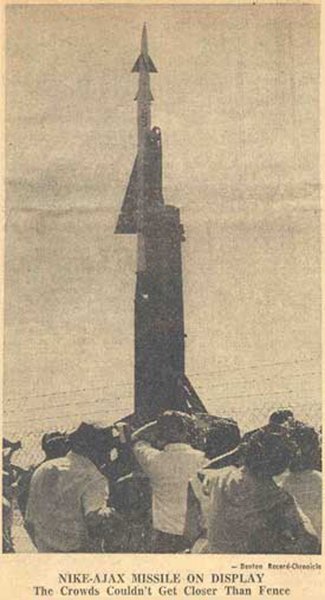
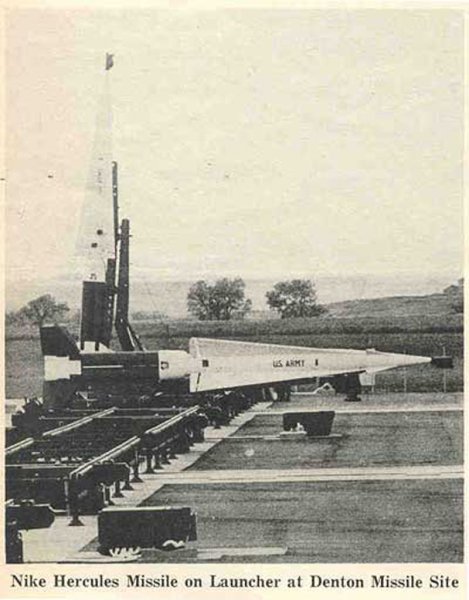

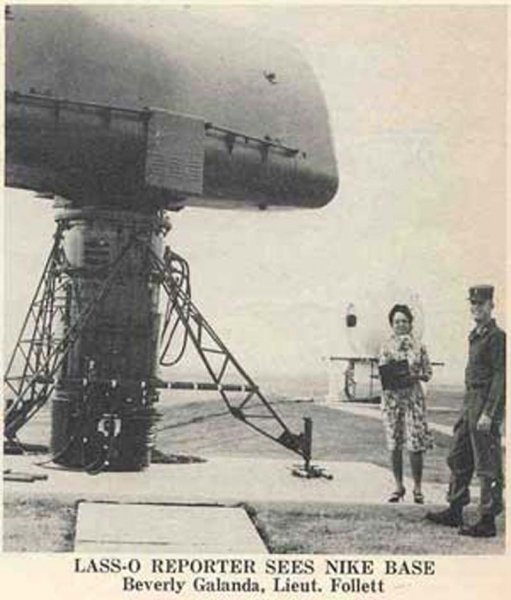
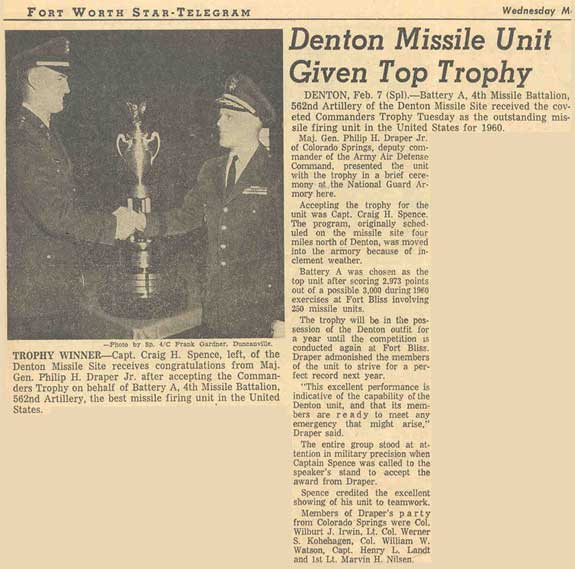

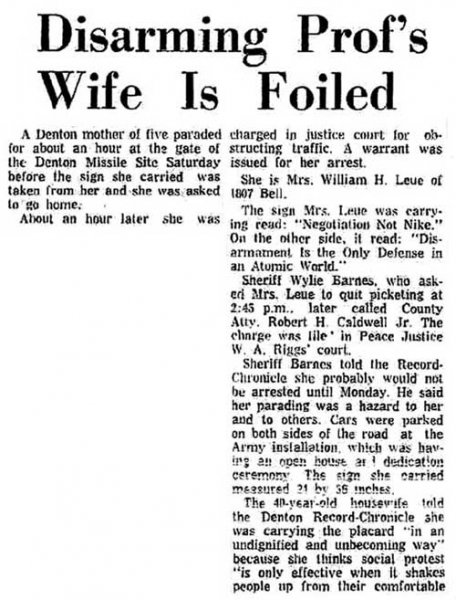
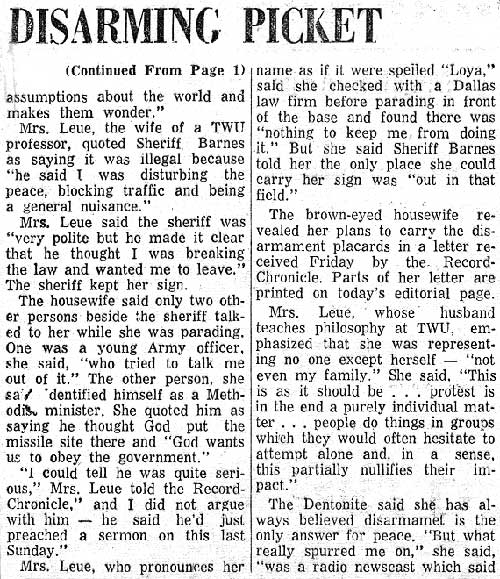
This last article about the protesting professor’s wife is interesting to me because I actually stumbled across Mrs Leue’s web site while searching for information about the Denton Missile Base. The reason her site was included in my search results is because she has an journal entry about the protest incident on her web site. If you would like to read her side of the story just follow this link: www.thoughtsnmemories.net.
Her take on the incident is a fascinating example of the problems of perception vs. reality. Take this quote from her web site for example:
I began walking back and forth, careful not to block the passage of huge limousines that were slowly driving up the ramp to the entrance.
Limousines? It seemed odd to me that there would be limousines at an event like this one. Mr. Dewlen was there for the opening ceremony, and here is what he had to say about the reported limos:
The army at that time used staff cars that were painted with olive-drab paint and were the most stripped-down Ford or Chevrolet sedans that you could buy, usually equipped with only a heater. (no radio AC, PS, PB, etc). They used borrowed air force school buses to transport visitors between the IFC and Launcher areas during the open house
So, you can see that while the vehicles at the ceremony may have been very official looking, they were hardly limousines. Reality vs. Perception.
Next, I have listed a few URLs with links to places with more information about the Denton Nike Base and/or the Nike Missile System in general:
Cold War Civil Defense Museum This virtual museum is dedicated to the Civil Defense and emergency workers of the United States who worked throughout the Cold War to try to protect the public from nuclear attack.
Cold War Civil Defense Museum: Nike Missile Base, Denton, TX A nice photographic tour of the Denton Nike base, focusing primarily on the current state of the north location (launcher area).
Ed Thelen’s Nike Missile Web Site Great coverage of the Nike System and its history.
Ed Thelen’s Nike Missile Web Site: Texas Nike Bases List of Nike bases in Texas, including the Denton site.
Ed Thelen’s Nike Missile Web Site: Nike Site SF-88 Photo Tour A photographic tour of a fully restored Nike Missile Base in the San Francisco area.
Rings of Supersonic Steel Features the book Rings of Supersonic Steel by Mark Berhow and Mark Morgan. This book is a fantastic resource for information about the Nike Missile System.
The Nike Historical Society The Nike Historical Society is a non-profit organization founded to preserve, in history, the critical role Nike Missile Systems played in the air defense of our nation and other nations throughout the free world.
And, finally, I have a couple of aerial photographs of each Denton location annotated to help identify buildings and structures:
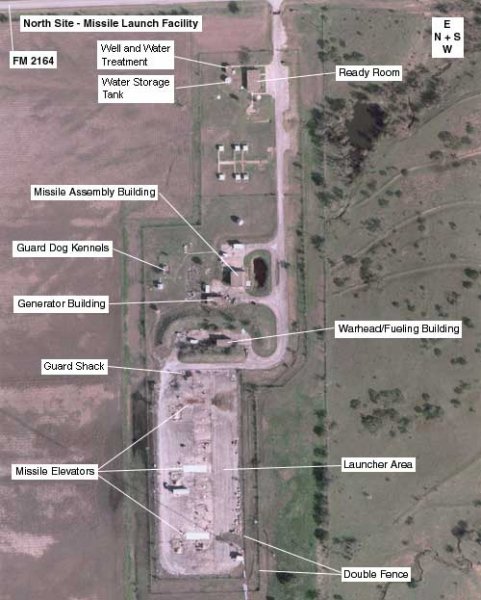
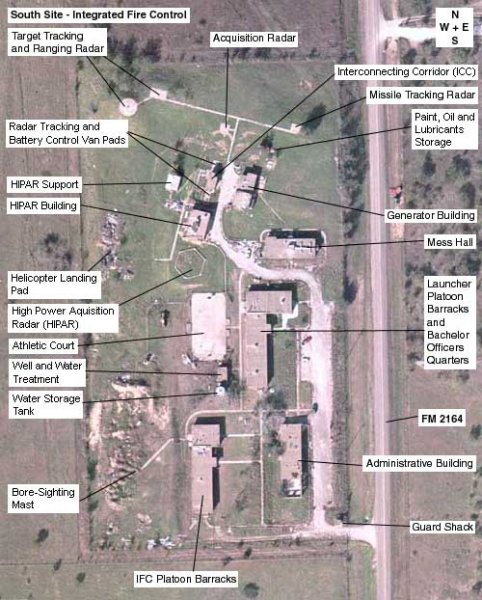
At long last I had all of my questions about the Denton Missile Base answered! But, then Don Franklin threw me one last curve…
When I returned to this area in 2001, after retiring from a career in Corporate Aircraft maintenance, I started a Denton Missile Base reunion group. We currently have about 40 people (Bob has found many of them via the internet) that served here in the early 60’s as well a having confirmed several that have died since then. The local guys, numbering about 20 or so, meet quarterly for a breakfast and bull session to discuss the “good old days” and or lives since then.
It turns out that the real story about the Denton Missile Base is that the servicemen who worked there in the 1960’s valued the experience so much that, after all this time, they still get together periodically to catch up and talk about the old times.
This past Saturday they had another one of their quarterly get-togethers, and Don and Bob were kind enough to invite me to come along. I gladly accepted, and met the group early on Saturday morning at Ruby’s cafe on the square in beautiful downtown Denton. I found the group in the very back of the cafe, busy with breakfast and storytelling.
Over breakfast I was treated to ribald tales of the good, the bad, and the ugly. I heard stories of competition and triumph. I listened to tales about gags and pranks. I was told about problems and resolutions. I witnessed some amazement about the amount of responsibility entrusted to their young stewardship. It was all very interesting.

Bob Dewlen, Nicky Hutcherson, Dennis Barrett,
Abel Gonzolez, Joe Hosick, Larry Howell,
Lania Rose, Gary Chandler (kneeling).
After breakfast, the others called it a day, but Bob Dewlen stuck around, and the two of us spent the rest of the day site seeing and exploring. First Bob took me on a tour of his old stomping grounds in Denton proper. He showed me the gas station where he worked to supplement his military pay, and then he showed me the old drive-in restaurant that was a favorite hangout of the servicemen when off duty.
Next we went out to historic Hartlee Airfield in northeast Denton. Rumor has it that this airfield now belongs to Don Carter, former owner of the NBA’s Dallas Mavericks.
From Hartlee’s we went in search of the old College/Denton Field airport. We felt that if we could locate the airfield we would be able to verify if it was related to the Nike base in any way. After a good deal of searching we were finally able to find the airfield’s location. The airfield is long gone now. The airstrip is grown over and bisected by highway Loop 288, and a residential subdivision is being built on top of the southern part of the airfield. Using various landmarks we were able to verify our position as a little over a mile away from the south Nike site. At that distance, while still possible, it seems unlikely that the two sites are related to each other.
Next we headed over to the Nike Base IFC (the south site) at 1:00 pm. Don had arranged for us to meet with the current owner of the IFC at 1:00 pm. The IFC is now the private residence of a man who values his privacy. In spite of this, he very graciously gave us a complete tour of the entire complex, spending several hours of his time in the process. In addition, he had a great aerial photo of the base taken just after construction was completed, and another of just after the base was closed. All in all it was a fascinating experience. We finished up with the IFC tour around 4:30 pm. Realizing that we had completely forgotten about lunch, Bob and I grabbed a quick snack at Braum’s before heading for home.
I have to say, that after 25 years of wondering, it is great to finally know the story behind these two ex-military facilities. I’m sure there are many other interesting stories about the Denton base. If you happen to know anything about it, and would like to share the information, please do not hesitate to contact me.
Addendum – September 7, 2019
I’ve recently discovered a few additional historic photographs of the Denton missile base that deserved to be shared here as well. See below…


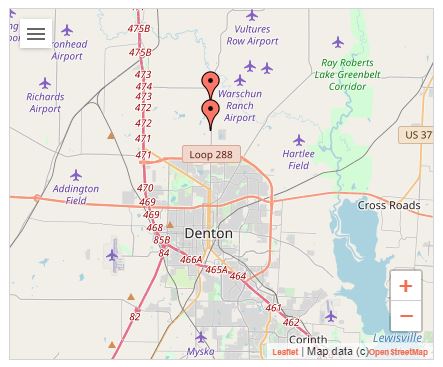

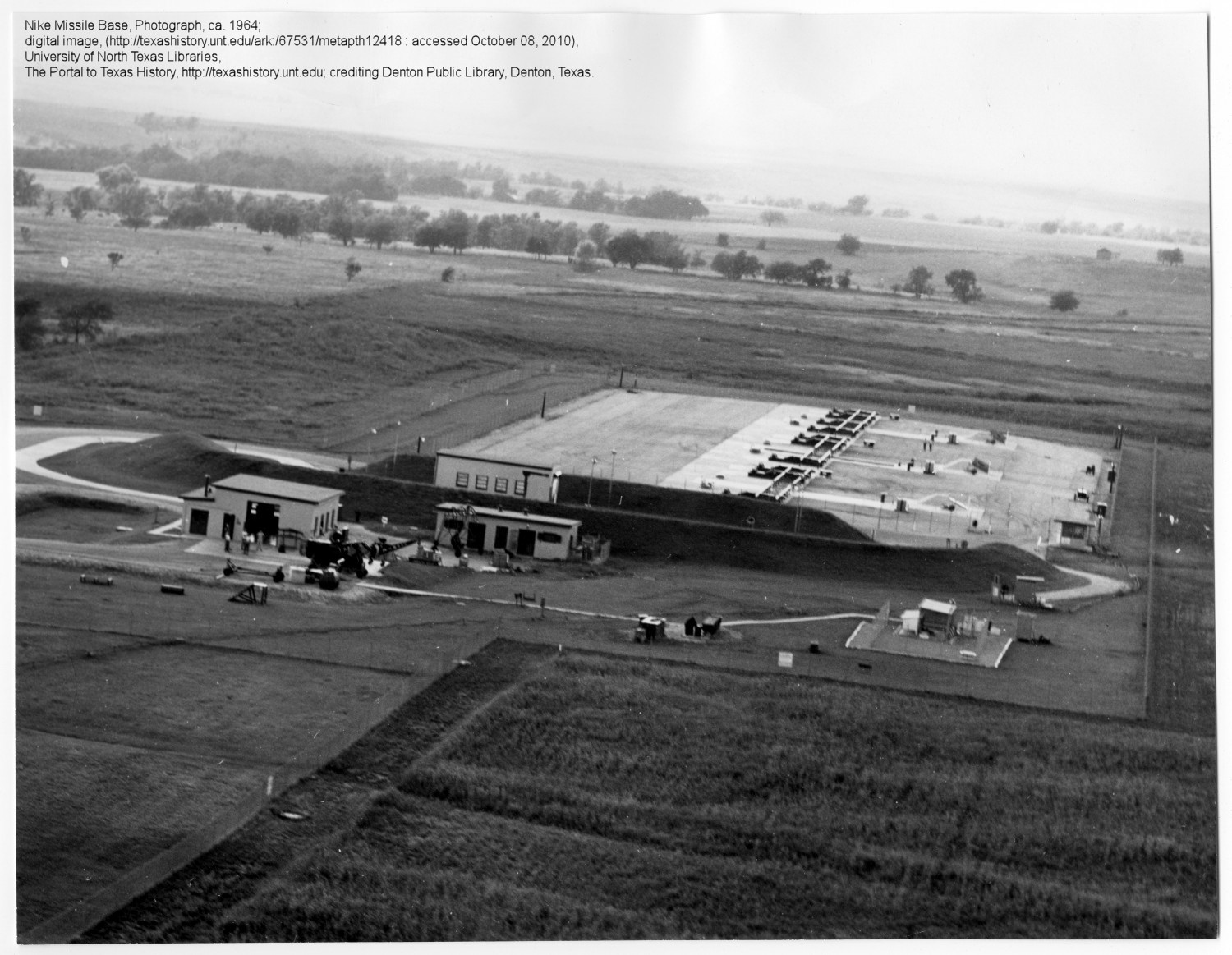



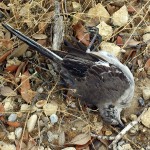


WOW. Thank you so much for doing all of this research. I lived most of my life in the neighborhood a few miles south of this base. I had heard tons of stories.
Great stuff!
Dan
This and other Nike bases are important historical sites. I’d like to see the state put up historical markers to commemorate the bases.
My dad< Dennis Barrett< was stationed at the base in the early '60s. We moved to EL Paso in '63. Dad retired in '67 then we moved back to Denton. Dad now lives in Nocona. He is 88 & his health is failing some. He was meeting with the guys until he got to where he could not drive anymore. Thanks for publishing the article & the group picture.
I met your dad at one of those Denton get-togethers several years ago. I’m glad you enjoyed the article.
Dear CGJ,
I was wondering if you could get me in cantact with Bob Dewlin or Don Franklin. I wanted to let them know that dad passed away this morning( 4-9-2012). You can reach me at this email address (XXXXXXXXXXXXXXX) or by cell phone XXXXXXXXXX.
Thanks so much for your help
Rick
I really liked your Story and the Follow up at the Ruby Diner I mostly grew up South of Denton until the Mid 80’s I lived in Sanger for awhile and Had Seen The Southern Part of the Base frequently and I remember the Observatory and Was interested in Whether the Base had been Sold or Not. I also Remember the Observatory for NTSU (UNT). I had always wondered if it had been one base, also. If the southern portion had been the Only portion I had seen. Are any of the Other facilities around Dallas/Ft.Worth are Available or still standing? My Family Has been around Denton for a Long Time and I remember Much of the Old Denton from the 60’s and 70’s but Wasn’t born until 64. Like the Drive Theater on the South side of town and the Scotty girl Sign for a burger Drive-in joint on University, The Zebra painted building on Fry st. Now used to be my Grandparents Beauty salon “Cecil and Helen’s” in the early 60’s.
Denton is a really great little town. Its has a great small-town feel, but the Universities and its proximity to Dallas means that you don’t have to give up much to live there—except rush hour traffic jams.
There ARE other old Nike Missile bases around the metroplex. In the 1960s the DFW was ringed by four bases. Its been a while since I did my research for this article, but I think the other bases where in Terrell, Duncanville, and Alvarado. I believe the Terrell base is privately owned now. The Duncanville base has been largely dismantled, I think. It looks like the Alvarado sites are holding up ok.
The Nike missiles at these sites were armed with nuclear warheads. It is wild to think about that… Nuclear weapons on such a small property, and secured by just a chain-link fence and a few guard dogs! Those were different times!
Here are some good links:
http://www.techbastard.com/missile/nike/dallas-tx.php
http://www.techbastard.com/missile/nike/sites/
Oh Also forgot we Have land North of Ft.Wolters Near Whitt And I remember the Helicopter sub bases where all around there in the 70’s. Outer Landing fields for flight training and landing Practice.
I live on 2164, curious who is squatting at the old base? People are living there
The south location has been a private residence for a number of years now.
Thanks so much for this! My family and I drove by this site this afternoon on our way to the lake, and it was the first time I had ever seen this building. We were intrigued and had never heard/seen this site before. Thank you for putting this out there!
Thank you so much for writing this article. My husband and I are born Texans but moved to Denton around 4 months ago. During a motor bike ride we passed the facility and was curious about this site and the history. We only live 3 miles from this place and never would have imagined a nuclear missile site. Thank you so much for sharing.
Its hard to believe they kept nuclear warheads on such a small piece of property isn’t it? Those were different times back then!
great article. as a young boyscout in the early 1960’s we were allowed to tour the facility and actually see a missile raised – fascinating ! and now I live about 3 miles away and can drive by daily.
Thanks for stopping by, Tom. I would have loved to have seen that place in operation!
I also enjoyed your article about the base. I found it as accurate as could be told this many years after the fact. I was just 17 yrs old and was an acquisition operator in the IFC, from 1962-1964 until the battery was deactivated. If there is anyone out there who remembers me, would be glad to here from you. What the hey it as only been 50 years ago.
Thanks, Wayne. Its hard to believe that its already been 8 years since I first put this article together. I’m going to see what I can do about putting you in touch with some of the servicemen mentioned in the article.
Hi, Wayne.
I am a documentary film-maker and would be very interested in chatting with you about a film I am working on about this very subject matter. Would you consider contacting me so I can share more information with you? I would be very interested to hear your account of what your experiences were in the years you were in Denton.
Thanks!
-Andy LaViolette
214-629-5384
info@mrmagicproductions.com
Hi Wayne La Violette I am Jim Hall I was a computer operator at Denton reporting there with the first ones there from Wolters and served until July 1962 I have been back there a couple of times , what a blast I was back a couple of times and had lunch with Don Taylor Bob Dewlen Lew Hawes and a group of the guys Would love to hear from you- – – – Jim
Jim Hall
480-677-9344
During the Cuban Missile Crisis (1962), The Record-Chronicle ran a photo of the missiles raised out of the silos with text that indicated that were ready to be fired at Havana.
Tongue-in-cheek for sure, but it would be fun to see that picture and caption. I wonder if there is any chance they still have it in their archives?
Made many trips to the denton site from 1st SAM in ft worth. Worked with 1st SAM at Denton. Some 1st SAMMERS still around.
An excellent article exhibiting solid and detailed research. Having served at all echelons of Nike installations including NORAD I congratulate you and thank you for your effort.
Thank you for saying so, Travis. That article is a favorite of mine!
I would have been about 10 years old, but I remember seeing missiles being transported through downtown, heading north on Locust St. as I remember (or it could have been Elm St. since they were not one-way streets at that time).
Finally! Some information that I was curious about. I lived in South Fork for 5 years and always saw the base from my home. When I was a kid in the early 2000s, I would go to the old Observatory when my sister took me, because she was a lab assistant there for Astronomy. But, what I still wonder is if the Base had tunnels circulating underground throughout Denton? I found a concrete air vent structure in South Fork and realized there was a tunnel under ground. Were there tunnels leading to the missile base?
Hi, Cheyenne.
I am a film-maker and working on some research in regards to your question. I would love to chat on the phone or via email about information I have about your question. Please feel free to call or email me anytime.
Thanks!
-Andy LaViolette
214-629-5384
info@mrmagicproductions.com
Hi, Cheyenne.
I would be interested to share some information with you about the existence of tunnels in Denton. Please contact me any time you have a moment to chat.
Thanks!
-Andy LaViolette
214-629-5384
info@mrmagicproductions.com
Regarding tunnels, you might look at this:
http://dentonsecrets.com/
I cannot vouch for any of that, and am skeptical at best, but have at it…
I have a question not directly related to the Nike site, but some “knowledgeable individual” familiar with the area might be able to help me.
I am looking for another underground site north of Denton. It was in the area just north of the Nike site, I believe. I toured the site back around 1980 with FEMA. They described it as the “Little White House”, and would be where the President would relocate to in case of a major emergency. It was very low-key, as you might expect, but it was within 100 yards of a two-lane road as I recall. The above-ground portion of the installation was a very light blow-away type structure. I don’t recall a guard post at the gate, but I might not remember because we didn’t have to show ID due to being on a scheduled FEMA tour.
I’d like to know if someone can firm this site’s location and if it still exists. From what I can remember, it looked to have been built back in the 50s and might have been abandoned or sold-off at some point. If one of the Nike missile sites is now a private residence, then this site might be as well.
Any help in locating this site would be appreciated. My email is: michaelclick@earthlink.net
FEMA has a facility in Denton on Loop 288 just south of University (380). This is probably the place you are thinking of. Here is the location on Google Maps:
https://www.google.com/maps/@33.2216922,-97.0907074,649m/data=!3m1!1e3?hl=en
Michael.
I am working on a project associated with what you are talking about and would be very interested in speaking with you. Please give me an email or a phone call anytime you’re free.
Thanks!
-Andy LaViolette
214-629-5384
info@mrmagicproductions.com
Ive been down in the bunker at fema denton tx a few times not sure about any tunnels but know theres 2 floors down there
I was stationed at Fort Walters from 1962 through 1965 at battery D,4th missile Battalion, 562nd artillery. Have many memories of that place. Just 17 years old when I went there. They changed from camp to fort Walters in 1963. Would like to see it again!
Hi, Owen.
I am working on a documentary which includes the Nike Missile project and I would love to talk to you more about your memories of your time at the base. Would you be interested in chatting?
Thanks!
-Andy LaViolette
info@mrmagicproductions.com
214-629-5384
I heard that there were tunnels under the southern facility. Do you know if this is true and if so, do you have any idea where the stairway is located on the land? In all your talking to the guys who were stationed there, did any of them mention that? I used to know the guy who lives there now and he was always talking about it, just wondering if he found it or if it even exists.
I never saw any evidence that would lead me to believe there are tunnels under the base.
I used to take my dates and go “parking” down that lonely road back in the early 60’s. Figured if we have to go because of a Russian missile strike, might as well be at the center of it. We were proud of our Nike base though. Then there was the “Texas White House”, a bunker type underground headquarters where President Johnson would go to if he were in Texas. This facility is still in use by FEMA today and is located on the south side of Denton.
My father was stationed at the Alvarado site from 11/59 until 1/64. It was Battery C, 4th Battalion, 562nd Artillery. He was a section chief at the launching area. When it first went IOC in 1961 it also had one Ajax and two Hercules sections. I remember visiting the base every holiday to have dinner with the soldiers. I saw the missiles standing on several occasions. It stood down in late 1968 and and was closed a year later after ten years of standing guard over DFW. I have to say that the Denton site, due to its location, had to be the prime location. Alvarado, Terrell and Mineral Wells were just small farm towns with not much to offer as entertainment.
There was a reunion at the base of former soldiers stationed there in Oct 2010. About 15 men and their families attended on a sunny afternoon. Unfortunately my father had passed eight years earlier and I attended in his honor.
Both units of the base are still in relatively good condition. The IFC is a private residence with most buildings still standing and in good repair. While heavily overgrown with vegetation, the launching area is still there. We were able to actually go underground into one of the magazines. It still had lighting and had been used for storage by a local explosives company.
Duncanville was mentioned in the original article. It was Headquarters Battery, the battalion administrative section. It had no missiles, only offices. The Terrell location is mostly delapidated as is the Mineral Wells location on the far north end of the former Fort Wolters.
I forgot to mention that the Alvarado veterans group has a Facebook page: https://www.facebook.com/groups/Alvarado.Nike.Site/
Awesome. Is it still a viable location for some other type of situation? Have new tunnels been added? Does FEMA use it for anything? Do other tunnels exist underneath Denton – as other sites claim.
Wow! Thanks for the wonderful history on this site. I remember actually exploring that site as a kid when it was used by UNT for storage of stuff.
Thank you for the info! My husband and I drive by this pretty often and have been wondering what this area was. Thank you for solving the mystery and for the great read!
Hello! This was a great story. My dad was stationed in launcher three. Dad served at the Nike base from 1963 until 1969 when the last missiles were removed. The base had shut down defense operations in 1968. My dad remained to close out the facility ending in.
I was With D 4 65 arty located in Van Nuys California from 1961 to 1963 and transferred to Nike base in Germany, retired in 1983 after 22 years, would like to attend a meeting some time if one comes up, Do you remember the Cuban threat.